
Remote Piloted Aerial Vehicles : An Anthology
The first air raid - by balloons! On August 22, 1849, the Austrians, who controlled much of Italy at this time, launched some 200 pilotless balloons against the city of Venice. The balloons were armed with bombs controlled by timed fuses - they are also said to have used fuses electrically activated via signals fed up trailing copper wires (to be confirmed - Ed.). Some of the bombs exploded as planned but the wind changed direction and blew several balloons back over the Austrian lines. This is, by most accounts, the first recorded action of its type....more about this story Table of Contents
Preamble
RPAVs in Australia The History of Rockets and Military Rocketry Preamble
Box Kites and the US National Weather Service, 1900-1930 Flying Wings : Sydney University of Technology, 1947
The purpose of THIS essay is however, to academically look at the other side of the coin, the side that (in this authors opinion), not only gets the most publicity and the most R&D money but, in the end, also then causes the most harm. Sad but true. Beginnings
On August 22, 1849, the Austrians, who controlled much of Italy at this time, launched some 200 pilotless balloons against the city of Venice. The balloons were armed with bombs controlled by timed fuses - they are also said to have used fuses electrically activated via signals fed up trailing copper wires (to be confirmed - Ed.). Some of the bombs exploded as planned but the wind changed direction and blew several balloons back over the Austrian lines. This is, by most accounts, the first recorded action of its type
[Editors' note: This experimental idea became the first use of aerial bombing, and its effect, though minor, contributed to the collapse of the Venetian revolt.]
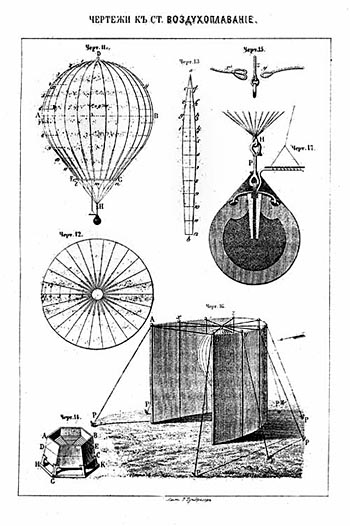 Bombing by Balloon, 1848 Source : Prof. Jurij Drushnin, Moscow, Russia
also... In 1848, the citizens of Venice tossed out the occupying Austrians, and proclaimed a Venetian Republic. Predictably, this didn't sit well with the Austrians, and they returned in force to make mischief but encountered difficulty. In particular, Austrian Lieutenant Uchtaius looked about Venice and saw that, for the purposes of laying siege to the city, the topography was wanting: he had trouble placing big guns in a position to properly shell the Italians. Instead, the Lieutenant imagined that lightweight hot air balloons constructed of paper could loft a payload of ordnance into the city. Such balloons were crafted and carried 33 pounds of explosives, set with a half-hour time fuse, and troops scurried around with them to launch them into the proper wind currents. In Japan's World War II Balloon Bomb Attacks on North America, Robert C. Mikesh details the project's efficacy: No great material damage was done to the enemy, though one of the charges burst in St. Mark's Square. An unexpected shift of the wind drove some of the balloons back to the besiegers and their use was abandoned. an email received from Michael White in late 2005 stated...
Regards your story over the Austrian bombing of Venice. The story is valid but just to inform you the Russian origin drawings explaining the Austrian Bombing of Venice are not authentic or original.also... The first recorded use of an aerial device from aboard a ship occurred in 1806, almost 100 years before the Wright Brother's first powered flight at Kitty Hawk in December 1903. On that occasion, the Royal Navy's Lord Thomas Cochrane flew kites from the 32-gun frigate HMS Pallas to spread propaganda leaflets over the French coast. Some 43 years later, on July 12, 1849, the Austrian vessel Vulcano launched a manned hot air balloon to drop bombs on Venice. However, because of unfavorable winds, the attempt was unsuccessful. http://www.geocities.com/~sandcastle/cvchap1a.htm
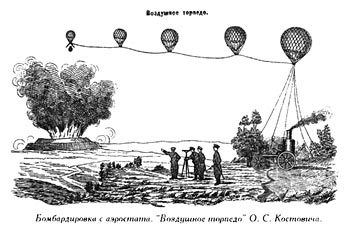 Aerial attack by balloon, 1880 Source : Prof. Jurij Drushnin, Moscow, Russia
Aerial Bombers "Designs Ahead Of Their Time" http://civilwar.bluegrass.net Ballooning began in America in 1793 and by the end of 1861 the Union army, with the influence and guidance of Thaddeus Lowe, had five hot-air balloons- their first "aeronaut corps". All of the balloons in use during the Civil War were used strictly for reconnaissance. While many aeronautical designs were submitted to the U.S. Patent Office during the Civil War years, only a few inventors combined the idea of flying machines with offensive military operations; none of these saw use during the Civil War. In June 1862 Luther C. Crowell of West Dennis, Mass., received a patent for a flying machine capable of carrying a bomb load. The sharp-edged hollow wings of the machine were designed to hold hydrogen gas, and with the power of a steam engine located in the cab, the wings were to pivot from a horizontal to a vertical position. Dual propellers linked by chains or bands were to revolve in opposite directions, and they were also hinged so that they could function both vertically and horizontally. This aerial bomber had a cone- or pyramid-shaped rudder, and the craft was designed to take off and land vertically. In February 1863 Charles Perley of New York City was awarded a patent for an unmanned aerial bomber. His design was a hot-air balloon that carried a basket containing a timing mechanism. The timer would trip a hammer on a cylinder to eject a hinge pin, opening the hinged basket at the bottom so that the bomb would drop out. The ejection on the hinge also ignited the bomb's fuse. Perley recommended that operators first send up test balloons or gas bags to check the speed of the air current so that they could set the timing device accurately. Of course the aerial bomber also had to be sent up directly to the windward side of its target. A Confederate veteran recalled an attaché' to the Confederate War Department who appealed for money through Richmond newspapers to build a big balloon. "He said that with it he could fly over Grant's army, and by dropping explosives annihilate them." In the Civil War era, men envisioning aerial bombers were considered cranks, not progressive forward thinkers ahead of their time. Radiodynamics : the art of controlling distant mechanisms without artificial connecting means
In the year 1897, when wireless telegraphy was still in its infancy, Ernest Wilson, an Englishman, was granted a British patent on a system for the wireless control of dirigible, self-propelled vessels. The primary object of this invention was to provide a weapon for use in naval warfare, which, if in the form of a dirigible torpedo, controlled from a shore or ship wireless installation, would be most deadly in its effect on a hostile fleet. No mention has been found of actual apparatus constructed according to Wilson's plans. ...more Further Reading Radiodynamics. The Wireless Control of Torpedoes and other mechanisms; New York: D. Van Nostrand, 1916, 206pp + 43pp book catalog. 112 illus. Nikola Tesla and his 'Teleautomata'
Telautomats will be ultimately produced, capable of acting as if possessed of their own intelligence, and their advent will create a revolution.Telautomata http://onlinetools.chipcenter.com/netsim/tesla/tesla2.html - site no longer online
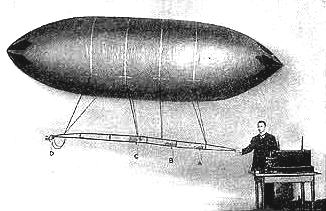 Nikola Tesla with his wireless controlled airship c.1900
The idea of banishing warfare by making it inconceivably horrific was a widely held conceit pretty much until the end of WWI. Even at the time, though, it was less popular with the literary crowd Tesla had insinuated himself with (although his good friend Samuel Clemens encouraged him to continue this work). Moreover, by this time his wild prognostications had caused many former colleagues to openly distance themselves and to belittle his inability to deliver inventions equal to the extravagent claims he made for them. Tesla had reached the zenith of his notoriety and the fall from this state of grace would be long and painful.
On November 8th, 1898, Tesla obtained a patent for the remote control, for which he had applied four months earlier on July 1st. This patent is the basis of contemporary robotics. The site features a video showing a transparent hull, working replica of his wireless remote controlled boat of 1898 [9Mb file]
"...What Tesla did was to demonstrate the possibility of remote control by radio waves. In the artificial lake, the audience saw a six-foot, iron-hulled boat decorated with tiny electric lights. Ever the master showman, Tesla invited the crowd to shout out commands, "Turn left! Turn right! Flash the lights!" In response, Tesla signaled the boat using his wireless transmitter and the boat executed the command. With the Spanish-American War just over, Tesla described how he could easily build a larger boat, arm it with dynamite, and then steer it by remote control toward an enemy ship. Here, one hundred years ago, was a prototype for the Cruise missiles used in the recent wars in Iraq and Kosovo....more
Sample page at right (page1 of 5 pages of drawings, the remaining eight pages contain the supporting text) You will need to use Stuffit Expander (or similar eg: PKZip) to decompress these pages. Stuffit Expander and PKZip are available free from tucows.com Gabet and his 'Torpille Radio-Automatique', 1909
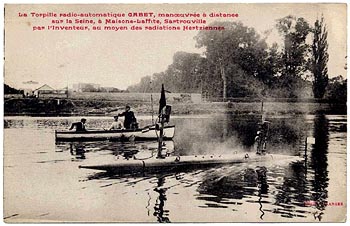 Gabet and his Torpille Radio-Automatique, 1909 Source : Philippe Gervais
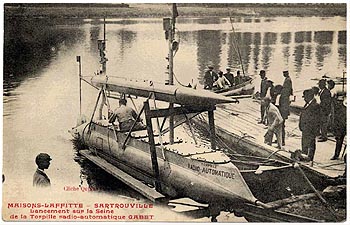 Gabet and his Torpille Radio-Automatique, 1909 Source : Philippe Gervais
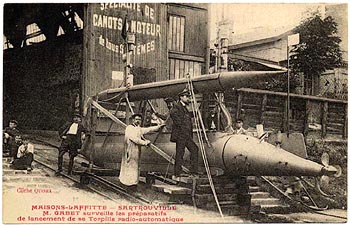 Gabet and his Torpille Radio-Automatique, 1909 Source : Philippe Gervais
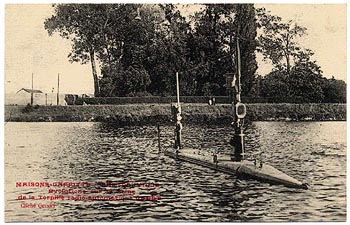 Gabet and his Torpille Radio-Automatique, 1909 Source : Philippe Gervais

Gabet and his Torpille Radio-Automatique, 1909 Source : Philippe Gervais
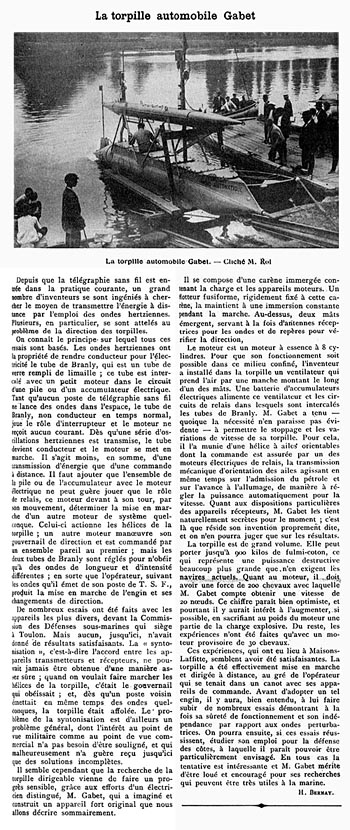
Gabet and his Torpille Radio-Automatique, 1909
Radio Controlled Aircraft : A Brief History Probably the first really successful R/C aircraft were Fairey IIIFs which were modified with more dihedral as part of a programme at the Royal Aircraft Establishment (Farnborough). They had a simple R/C system. The aircraft became known as Fairey Queens which explains why subsequent R/C drones were called the Queen Bee and the Queen Wasp. About the same time, Major Raymond Phillips was touring the country (Britain) giving displays with his electric powered airship ... it used a spark transmission system and a method of sequential controls. In 1934, Reginald Denny (screen actor and modeller) produced a nine-foot R/C model which he tried to sell to the Army for target practice for AA gunners. It crashed on a demo but a later version with 5 (tone) channels worked well and went into production. The plant was named Radioplane Inc. and one of its employees on the wing assembly was Norma Jeane Baker of whom you may have heard (aka Marilyn Monroe). In 1936, Ross Hull produced an R/C glider with a sequential escapement system turned by rubber strip. In 1937, R/C was introduced as an event at the US Nationals and was won by Chester Lanzo, though Chester confided that there was more radio than control. In 1938, the Good brothers entered and won, though the stab got knocked out of alignment at take-off and the control wasn't great. Next year they got it all together and won again. The 1938 plane can be seen in the Aerospace Section of the Smithsonian. Further Reading
also...
Cruise Missiles: a Brief History
Strategic and Tactical Missiles and last but by no means least
Seeking Guidance Long before Paveway laser-guided bombs blew up the bridges in North Vietnam, the U.S. Air Force experimented with radar-guided bombs. In a 1987 case study "The Quest for a Surgical Strike: The Air Force and Laser-guided Bombs," Air Force historian David R. Mets traced the precursors to the Paveway weapon guidance kits. The following is excerpted from that case study with permission. [to the original site [Ed.]] ...more should this link fail, a cached copy is also available
At a top secret base in the Nevada Desert, deep inside a place known to the world as Area 51, the US government are testing their most secret weapon: an unmanned strike aircraft designed to destroy the most advanced air defences and render any nation open to destruction from the sky. Imagine a plane invisible to radar that flies by itself using its own advantaged neural network computers. Imagine a robot plane as small as a dragonfly, with a video camera the size and weight of a grain of rice and an electronic nose guided by human sweat. This is not science fiction. These weapons are being constructed today. They are the new warriors - the robot warriors. Robot planes first flew as long ago as the First World War, when a flying bomb was designed with a clockwork device that sheared the wings, letting the 'bomb' drop automatically. In the Second World War, the Nazis built the V I and V2 flying bombs and in Vietnam, top secret squadrons of robot reconnaisance aircraft flew missions too dangerous to risk pilots' lives. Today's UAV's (Unmanned Aerial Vehicles) are truly unbelievable. Their technology is so close to the cutting edge of science that they might just as well have been built by aliens. Robot Warriors reveals previously little-known developments by NASA and the US Department of Defence, and includes the unmanned HiMAT miniature jet fighter, and the X-36; the extraordinary Dark Star and Global Hawk projects; the Predator, currently patrolling the skies above Bosnia; and the unmanned squadrons that flew in the Gulf War. Finally there will be a look into the not-too distant future: dragonfly-sized UAVs that seek out specific targets; fighters that operate autonomously; and patrol reconnaissance aircraft that fly for weeks in the upper atmosphere. Robot Warriors concludes with the battlefields of the next century where robot planes will battle each other in a real-life video game. about the authors Hugh McDaid is a film maker whose credits include documentaries for BBC Horizon, Channel Four, Equinox and the Discovery Channel and David Oliver is the Editor of Air Forces Monthly magazine and is one of the world's leading experts on military aviation Admiral Barton Strong is Head of the joint Projects Office for Cruise Missiles and Unmanned Aircraft, for the US Department of Defence and General Ken Israel is Director of DARO Defence Airborne Reconnaissance Office, US Department of Defence
"UAVs Over Australia - Market and Opportunities""An Extended Role for Unmanned Aerial Vehicles in the Royal Australian Air Force" Wing Commander Mark Lax and Wing Commander Barry Sutherland http://www.defence.gov.au/aerospacecentre/publish/paper46.htm
|
© Copyright 1999-2002 CTIE - All Rights Reserved - Caution |
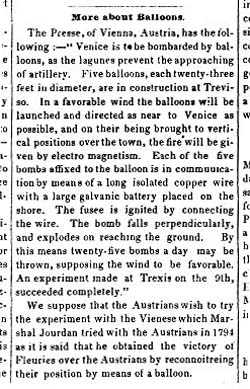 Scientific American, March 1849 "The Presse, of Vienna, Austria, has the following: 'Venice is to be bombarded by balloons, as the lagunes prevent the approaching of artillery. Five balloons, each twenty-three feet in diameter, are in construction at Treviso. In a favorable wind the balloons will be launched and directed as near to Venice as possible, and on their being brought to vertical positions over the town, they will be fired by electro magnetism by means of a long isolated copper wire with a large galvanic battery placed on the shore. The bomb falls perpendicularly, and explodes on reaching the ground."
Scientific American, March 1849 "The Presse, of Vienna, Austria, has the following: 'Venice is to be bombarded by balloons, as the lagunes prevent the approaching of artillery. Five balloons, each twenty-three feet in diameter, are in construction at Treviso. In a favorable wind the balloons will be launched and directed as near to Venice as possible, and on their being brought to vertical positions over the town, they will be fired by electro magnetism by means of a long isolated copper wire with a large galvanic battery placed on the shore. The bomb falls perpendicularly, and explodes on reaching the ground."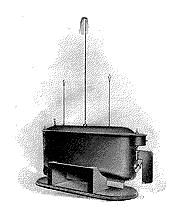 Well before the race for wireless telegraphy and as far back as 1893 in St. Nikola Tesla demonstrated remote control of objects by wireless. This was two full years before Marconi began his experiments. His demonstrations of remote control climaxed in an exhibition in 1898 at Madison Square Garden in which Tesla caused a small boat (right) to obey commands from the audience. Of course, it was Tesla interpreting the verbal requests and sending appropriate frequencies to tuned circuits in the miniature ship, but to the audience it was magic.
Well before the race for wireless telegraphy and as far back as 1893 in St. Nikola Tesla demonstrated remote control of objects by wireless. This was two full years before Marconi began his experiments. His demonstrations of remote control climaxed in an exhibition in 1898 at Madison Square Garden in which Tesla caused a small boat (right) to obey commands from the audience. Of course, it was Tesla interpreting the verbal requests and sending appropriate frequencies to tuned circuits in the miniature ship, but to the audience it was magic.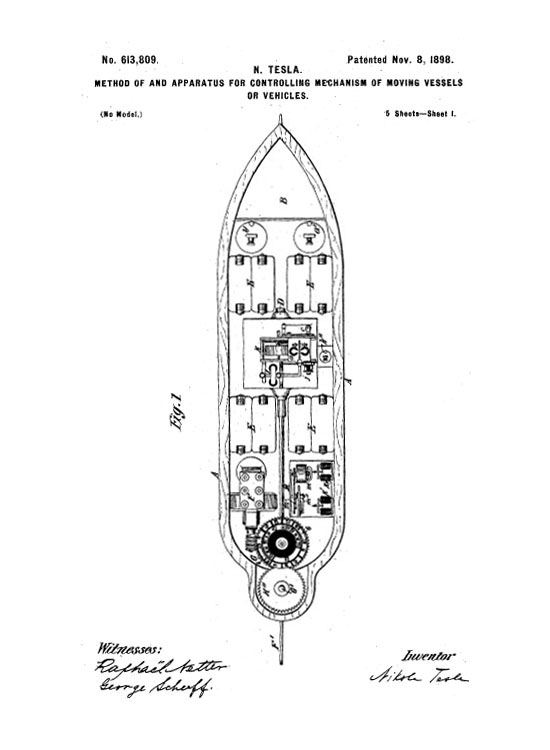 You may wish to download the
You may wish to download the 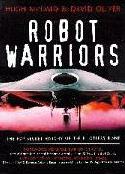 MCDAID, Hugh & OLIVER, David.: Robot Warriors. The Top Secret History of the Pilotless Plane. ; Orion Media, 1997. As new. 4to. Fine in dj. B/W & col. photos & illus. Examines the history & fututre of robot planes as well as revealing previously little-known developments by NASA & the US Department of Defence (at Area 51). 208pp.
MCDAID, Hugh & OLIVER, David.: Robot Warriors. The Top Secret History of the Pilotless Plane. ; Orion Media, 1997. As new. 4to. Fine in dj. B/W & col. photos & illus. Examines the history & fututre of robot planes as well as revealing previously little-known developments by NASA & the US Department of Defence (at Area 51). 208pp.